2020 MERCEDES-BENZ GLE COUPE engine
[x] Cancel search: enginePage 6 of 757
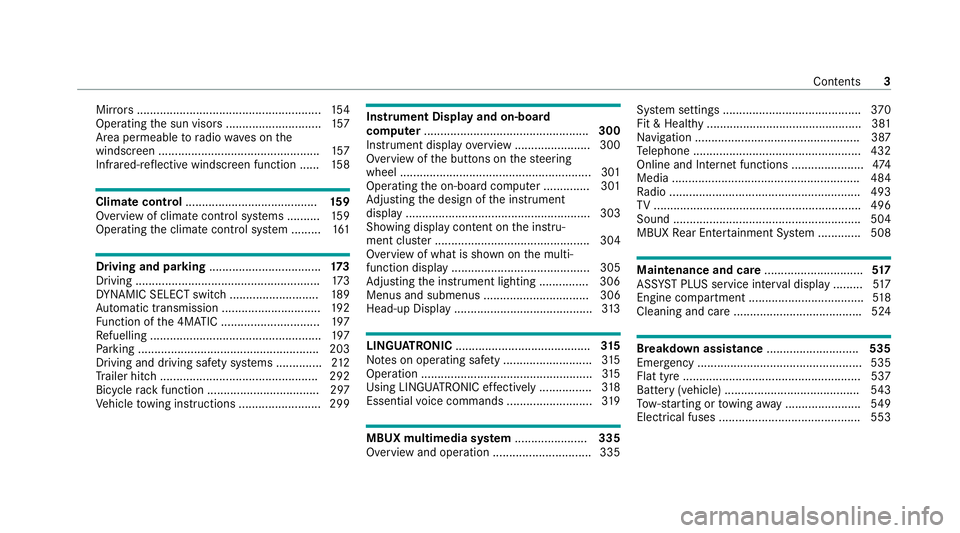
Mir
rors ........................................................ 154
Operating the sun visors ............................. 157
Area pe rmeable toradio wav es on the
windscreen ................................................ .157
Infrared-reflective windscreen function ...... 15 8Climate control
........................................ 15 9
Overview of climate contro l systems ..........1 59
Operating the climate control sy stem ......... 161 Driving and pa
rking .................................. 17 3
Driving ........................................................ 173
DY NA MIC SELECT switch ........................... 189
Au tomatic transmission .............................. 19 2
Fu nction of the 4MATIC .............................. 197
Re fuelling .................................................... 197
Pa rking ...................................................... .203
Driving and driving saf ety sy stems .............. 212
Tr ailer hit ch................................................ 292
Bicycle rack function .................................. 297
Ve hicle towing instructions ........................ .299 Instrument Display and on-board
comp
uter.................................................. 300
Instrument display overview ...................... .300
Overview of the buttons on thesteering
wheel ..........................................................3 01
Operating the on-board computer .............. 301
Ad justing the design of the instrument
display ........................................................ 303
Showing display conte nt onthe instru‐
ment clus ter ............................................... 304
Overview of what is shown on the multi‐
function display .......................................... 305
Ad justing the instrument lighting ............... 306
Menus and submenus ................................ 306
Head-up Display .......................................... 313 LINGU
ATRO NIC ......................................... 315
No tes on operating saf ety .......................... .315
Operation ....................................................3 15
Using LINGU ATRO NIC ef fectively ................ 318
Essential voice commands .......................... 319 MBUX multimedia sy
stem ...................... 335
Overview and operation .............................. 335 Sy
stem settings .......................................... 370
Fit & Healt hy............................................... 381
Na vigation .................................................. 387
Te lephone .................................................. .432
Online and Internet functions ..................... .474
Media ......................................................... 484
Ra dio .......................................................... 493
TV ............................................................... 496
Sound ......................................................... 504
MBUX Rear En tertainment Sy stem .............5 08 Maintenance and care
..............................517
ASS YST PLUS service inter val display ........ .517
Engine compartment ................................... 51 8
Cleaning and care ...................................... .524 Breakdown assistance
............................535
Emergency .................................................. 535
Flat tyre ...................................................... 537
Battery (vehicle) ......................................... 543
To w- starting or towing away ....................... 549
Electrical fuses ........................................... 553 Contents
3
Page 7 of 757
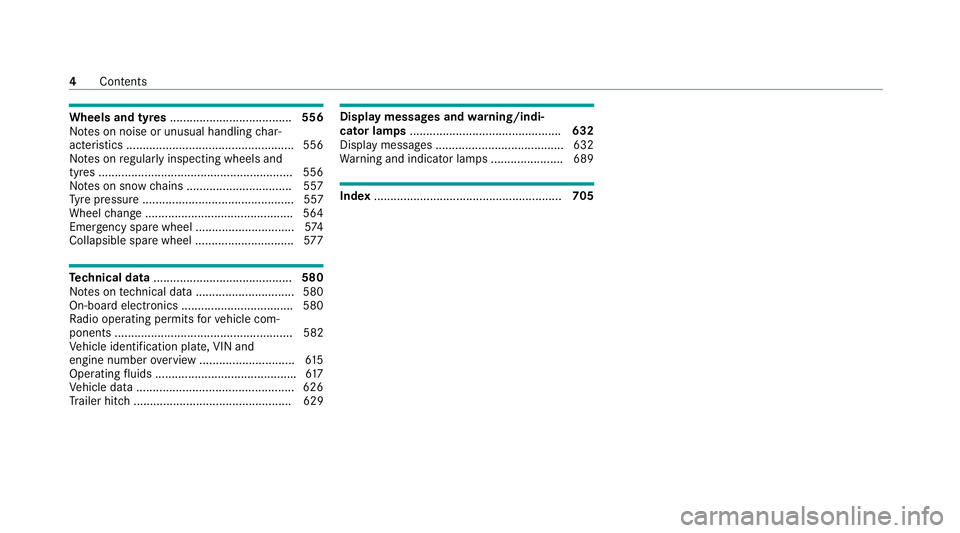
Wheels and tyres
..................................... 556
No tes on noise or unusual handling char‐
acteristics .................................................. .556
No tes on regular lyinspecting wheels and
tyres .......................................................... .556
No tes on snow chains ................................ 557
Ty re pressure .............................................. 557
Wheel change ............................................ .564
Emergency spare wheel .............................. 574
Collapsible spare wheel .............................. 577Te
ch nical data .......................................... 580
No tes on tech nical da ta.............................. 580
On-board electronics .................................. 580
Ra dio operating permits forve hicle com‐
ponents ...................................................... 582
Ve hicle identification plate, VIN and
engine number overview ............................ .615
Operating fluids .......................................... .617
Ve hicle data ................................................ 626
Tr ailer hit ch................................................ 629 Displ
aymessages and warning/indi‐
cator lamps .............................................. 632
Display messages ...................................... .632
Wa rning and indicator lamps ...................... 689 Index
......................................................... 7054
Contents
Page 14 of 757
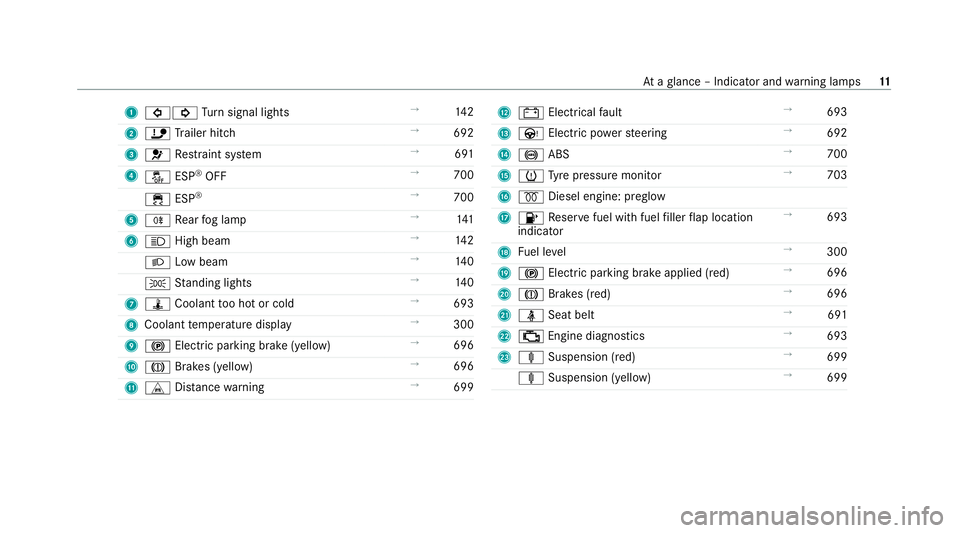
1
003E003D Turn signal lights →
14 2
2 ï Trailer hit ch →
692
3 0075 Restra int sy stem →
691
4 00BB ESP®
OFF →
700
00E5 ESP®
→
700
5 005E Rear fog lamp →
141
6 0057 High beam →
14 2
0058 Low beam →
14 0
0060 Standing lights →
14 0
7 ÿ Coolant too hot or cold →
693
8 Coolant temp erature display →
300
9 0024 Electric pa rking brake (yellow) →
696
A 004D Brakes (yellow) →
696
B L Distance warning →
699 C
003D Electrical fault →
693
D Ù Electric po werst eering →
692
E 0025 ABS →
700
F 0077 Tyre pressure monitor →
703
G 0028 Diesel engine: preglow
H 00B6 Reser vefuel with fuel filler flap location
indicator →
693
I Fuel le vel →
300
J 0024 Electric parking brake applied (red) →
696
K 004D Brakes (red) →
696
L 00E9 Seat belt →
691
M 00B9 Engine diagnostics →
693
N ä Suspension (red) →
699
ä Suspension (yell ow) →
699 At
aglance – Indicator and warning lamps 11
Page 25 of 757
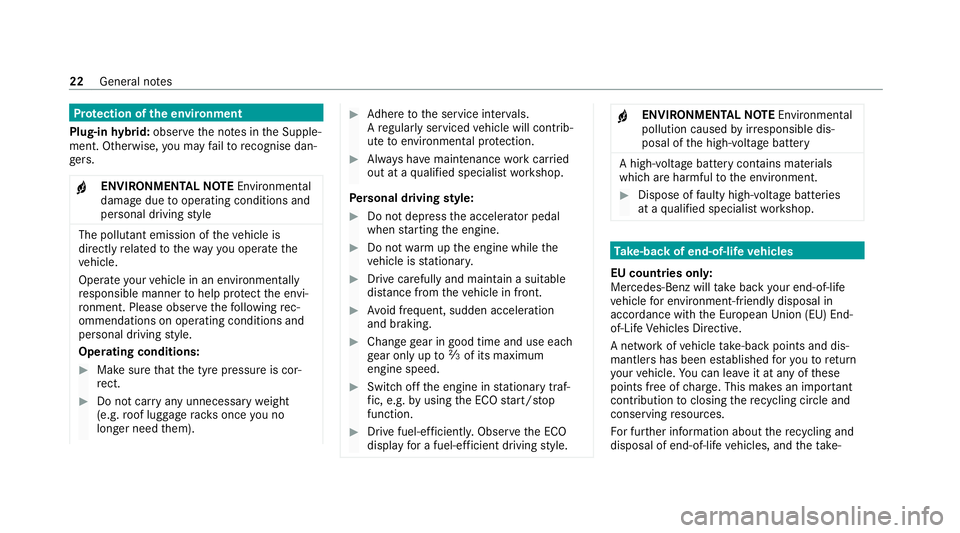
Pr
otection of the environment
Plug-in hybrid: obser vethe no tes in the Supple‐
ment. Otherwise, you may failto recognise dan‐
ge rs.
+ ENVIRONMENTAL
NOTEEnvironmental
dama gedue tooperating conditions and
personal driving style The pollutant emission of
theve hicle is
directly related tothewa yyo u operate the
ve hicle.
Operate your vehicle in an environmentally
re sponsible manner tohelp pr otect the envi‐
ro nment. Please obser vethefo llowing rec‐
ommendations on ope rating conditions and
pe rsonal driving style.
Operating conditions: #
Make sure that the tyre pressure is cor‐
re ct. #
Do not car ryany unnecessary weight
(e.g. roof luggage rack s once you no
lon ger need them). #
Adhere tothe service inter vals.
A regularly serviced vehicle will contri b‐
ute toenvironmen tal pr otection. #
Alw ays ha vemaintenance workcar ried
out at a qualified specialist workshop.
Pe rsonal driving style: #
Do not depress the accelera tor pedal
when starting the engine. #
Do not warm upthe engine while the
ve hicle is stationar y. #
Drive carefully and maintain a suitable
di st ance from theve hicle in front. #
Avoid frequent, sudden acceleration
and braking. #
Change gear in good time and use each
ge ar on lyup to00C3 of its maximum
engine speed. #
Switch off the engine in stationary traf‐
fi c, e.g. byusing the ECO start/ stop
function. #
Drive fuel-ef ficiently. Obser vethe ECO
display for a fuel-ef ficient driving style. +
ENVIRONMEN
TALNO TEEnvironmental
pollution caused byirre sponsible dis‐
posal of the high-voltage battery A high-voltage battery conta
ins materials
which are harmful tothe environment. #
Dispose of faulty high-voltage bat teries
at a qualified specialist workshop. Ta
ke -back of end-of-life vehicles
EU countries onl y:
Mercedes-Benz will take back your end-of-life
ve hicle for environment-friendly disposal in
accordance with the European Union(EU) End-
of-Life Vehicles Directive.
A network of vehicle take -ba ckpoints and dis‐
mantlers has been es tablished foryo uto return
yo ur vehicle. You can lea veit at any of these
points free of charge . This makes an impor tant
contribution toclosing there cycling circle and
conse rving resources.
Fo r fur ther information about there cycling and
disposal of end-of-li fevehicles, and theta ke- 22
General no tes
Page 54 of 757
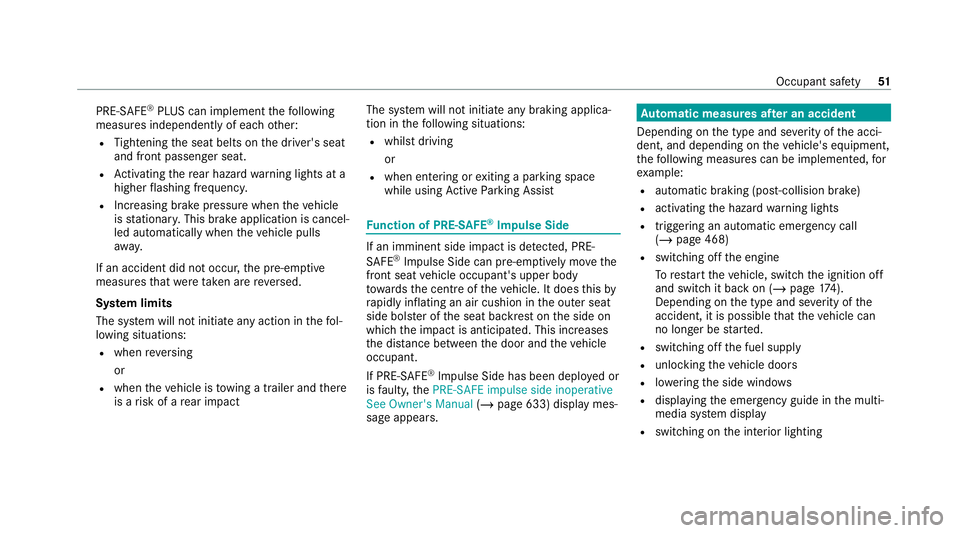
PRE-SAFE
®
PLUS can implement thefo llowing
measures independently of each other:
R Tightening the seat belts on the driver's seat
and front passenger seat.
R Activating there ar hazard warning lights at a
higher flashing frequenc y.
R Increasing brake pressure when theve hicle
is stationar y.This brake application is cancel‐
led automatically when theve hicle pulls
aw ay.
If an accident did not occur, the pre-em ptive
measures that we retake n are reve rsed.
Sy stem limits
The sy stem will not initiate any action in thefo l‐
lowing situations:
R when reve rsing
or
R when theve hicle is towing a trailer and there
is a risk of a rear impact The sy
stem will not initiate any braking applica‐
tion in thefo llowing situations:
R whilst driving
or
R when entering or exiting a parking space
while using Active Parking Assist Fu
nction of PRE-SAFE ®
Impulse Side If an imminent side impact is de
tected, PRE-
SA FE®
Impulse Side can pre-emptively mo vethe
front seat vehicle occupant's upper body
to wa rdsth e cent reoftheve hicle. It does this by
ra pidly inflating an air cushion in the outer seat
side bols ter of the seat backrest on the side on
which the impact is anticipated. This increases
th e dis tance between the door and theve hicle
occupant.
If PRE-SAFE ®
Impulse Side has been deplo yed or
is faulty, thePRE-SAFE impulse side inoperative
See Owner's Manual (/page 633) display mes‐
sage appears. Au
tomatic measures af ter an accident
Depending on the type and se verity of the acci‐
dent, and depending on theve hicle's equipment,
th efo llowing measures can be implemen ted, for
ex ample:
R automatic braking (post-collision brake)
R activating the hazard warning lights
R triggering an automatic emer gency call
(/ page 468)
R switching off the engine
To restart theve hicle, switch the ignition off
and switch it back on (/ page174).
Depending on the type and se verity of the
accident, it is possible that theve hicle can
no longer be star ted.
R switching off the fuel supply
R unlocking theve hicle doors
R lowe ring the side windo ws
R displaying the emer gency guide in the multi‐
media sy stem display
R switching on the interior lighting Occupant saf
ety51
Page 90 of 757
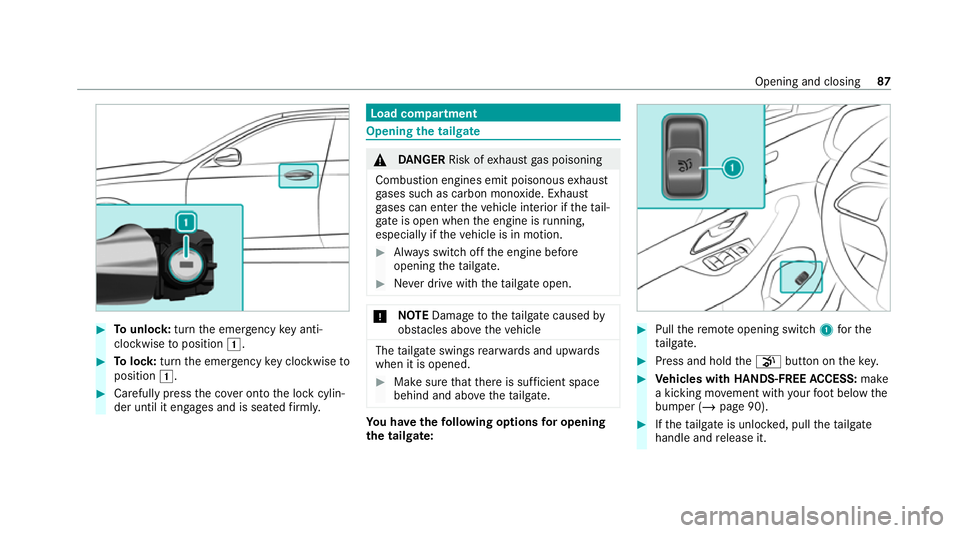
#
Tounlo ck:turn the emer gency key anti-
clo ckwise toposition 0047. #
Tolock: turnthe emer gency key clo ckwise to
position 0047. #
Carefully press the co ver onto the lock cylin‐
der until it engages and is seated firm ly. Load compa
rtment Opening the tail
gate &
DANG ER Risk of exhaust gas poisoning
Combustion engines emit poisonous exhaust
ga ses such as carbon monoxide. Exhaust
ga ses can enter theve hicle interior if theta il‐
gate is open when the engine is running,
especially if theve hicle is in motion. #
Alw ays switch off the engine before
opening theta ilgate. #
Never drive with theta ilgate open. *
NO
TEDama getotheta ilgate caused by
obs tacles ab ovetheve hicle The
tailgate swings rear wa rds and upwards
when it is opened. #
Make sure that there is suf ficient space
behind and ab ovetheta ilgate. Yo
u ha vethefo llowing options for opening
the tail gate: #
Pull there mo teopening switch 1forthe
ta ilgate. #
Press and hold the008B button on thekey. #
Vehicles with HANDS-FREE ACCESS: make
a kicking mo vement with your foot below the
bumper (/ page 90). #
Ifth eta ilgate is unloc ked, pull theta ilgate
handle and release it. Opening and closing
87
Page 105 of 757
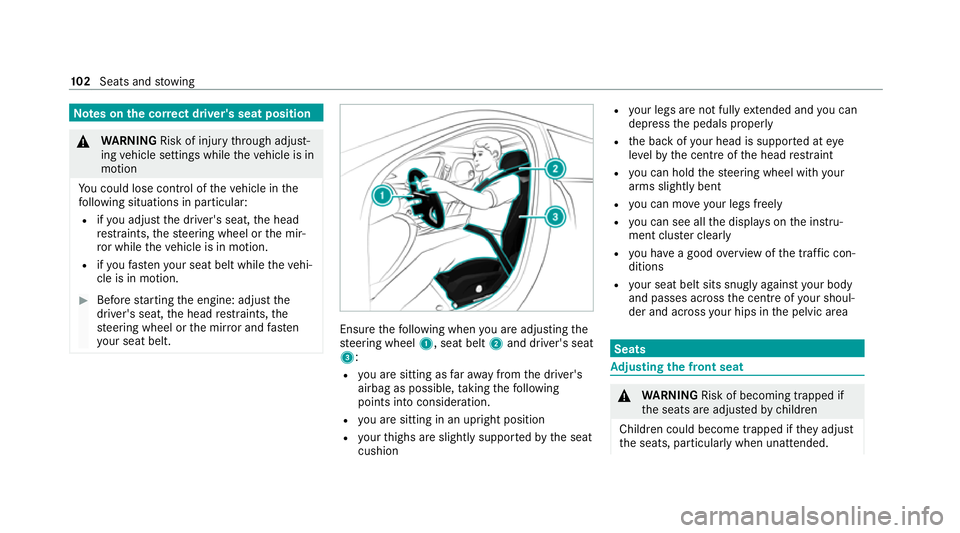
Note
s onthe cor rect driver's seat position &
WARNING Risk of inju rythro ugh adjust‐
ing vehicle settings while theve hicle is in
motion
Yo u could lose cont rol of theve hicle in the
fo llowing situations in particular:
R ifyo u adjust the driver's seat, the head
re stra ints, thesteering wheel or the mir‐
ro r while theve hicle is in motion.
R ifyo ufast enyour seat belt while theve hi‐
cle is in motion. #
Before starting the engine: adjust the
driver's seat, the head restra ints, the
st eering wheel or the mir ror and fasten
yo ur seat belt. Ensure
thefo llowing when you are adjusting the
st eering wheel 1, seat belt 2and driver's seat
3:
R you are sitting as faraw ay from the driver's
airbag as possible, taking thefo llowing
points into consideration.
R you are sitting in an upright position
R your thighs are slight lysuppor tedby the seat
cushion R
your legs are not fully extended and you can
depress the pedals properly
R the back of your head is suppo rted at eye
le ve lby the cent reofthe head restra int
R you can hold thesteering wheel with your
arms slightly bent
R you can mo veyour legs freely
R you can see all the displa yson the instru‐
ment clus ter clea rly
R you ha vea good overview of the traf fic con‐
ditions
R your seat belt sits snug lyagainst your body
and passes across the cent reofyour shoul‐
der and across your hips in the pelvic area Seats
Ad
justing the front seat &
WARNING Risk of becoming trapped if
th e seats are adjus tedby children
Children could become trapped if they adjust
th e seats, particularly when unattended. 102
Seats and stowing
Page 106 of 757
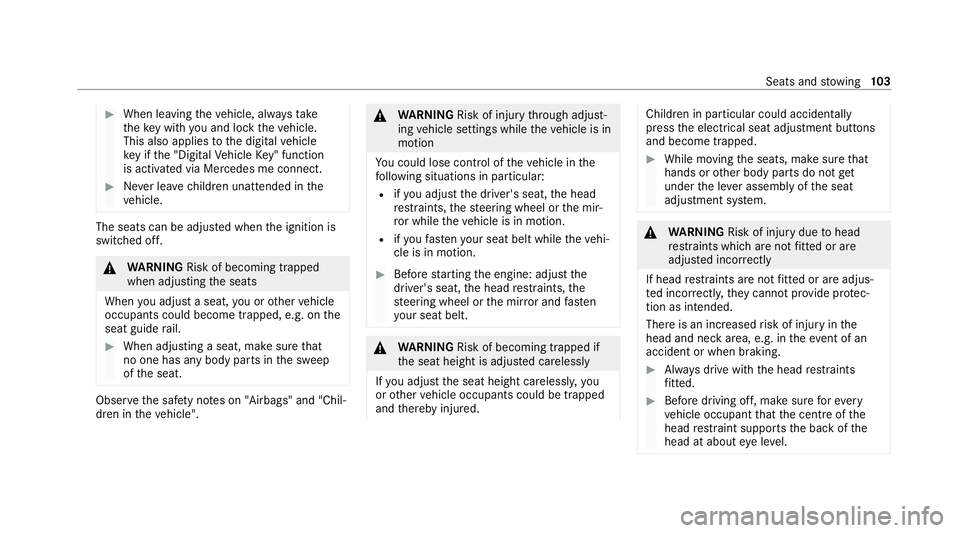
#
When leaving theve hicle, alw aysta ke
th eke y with you and lock theve hicle.
This also applies tothe digital vehicle
ke y if the "Digital Vehicle Key" function
is activated via Mercedes me connect. #
Never lea vechildren unat tended in the
ve hicle. The seats can be adjus
ted when the ignition is
switched off. &
WARNING Risk of becoming trapped
when adjusting the seats
When you adjust a seat, you or other vehicle
occupants could become trapped, e.g. on the
seat guide rail. #
When adjusting a seat, make sure that
no one has any body parts in the sweep
of the seat. Obser
vethe saf ety no tes on "Airbags" and "Chil‐
dren in theve hicle". &
WARNING Risk of inju rythro ugh adjust‐
ing vehicle settings while theve hicle is in
motion
Yo u could lose cont rol of theve hicle in the
fo llowing situations in particular:
R ifyo u adjust the driver's seat, the head
re stra ints, thesteering wheel or the mir‐
ro r while theve hicle is in motion.
R ifyo ufast enyour seat belt while theve hi‐
cle is in motion. #
Before starting the engine: adjust the
driver's seat, the head restra ints, the
st eering wheel or the mir ror and fasten
yo ur seat belt. &
WARNING Risk of becoming trapped if
th e seat height is adjus ted carelessly
If yo u adjust the seat height carelessly, you
or other vehicle occupants could be trapped
and thereby injured. Children in particular could acciden
tally
press the electrical seat adjustment buttons
and become trapped. #
While moving the seats, make sure that
hands or other body parts do not get
under the le ver assembly of the seat
adjustment sy stem. &
WARNING Risk of inju rydue tohead
re stra ints which are not fitted or are
adjus ted incor rectly
If head restra ints are not fitted or are adjus‐
te d incor rectl y,they cannot pr ovide pr otec‐
tion as intended.
There is an increased risk of injury in the
head and neck area, e.g. in theeve nt of an
accident or when braking. #
Alw ays drive with the head restra ints
fi tted. #
Before driving off, ma kesure forev ery
ve hicle occupant that the cent reofthe
head restra int supports the back of the
head at about eye le vel. Seats and
stowing 103